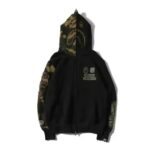In the vibrant and constantly evolving world of streetwear, BAPE hoodies stand as one of the most iconic and instantly recognizable garments ever created. With their bold designs, playful branding, and unmatched influence on global fashion culture, BAPE hoodies are more than just pieces of clothing—they are symbols of identity, exclusivity, and a lifestyle built on creativity.
This article takes a deep dive into the history, design, cultural impact, and timeless appeal of BAPE hoodies, explaining why they remain a must-have in every streetwear enthusiast’s wardrobe.
Origins: A Bathing Ape’s Rise to Fame
Founded in 1993 by Japanese designer Nigo (real name Tomoaki Nagao), A Bathing Ape—often abbreviated as BAPE—was born out of Tokyo’s buzzing Harajuku scene. Inspired by American hip-hop, pop culture, and Japanese anime, Nigo envisioned a brand that blended East and West through bold visuals, premium materials, and a strong sense of identity.
From the start, Nigo focused on limited production, making BAPE pieces hard to find and even harder to ignore. This scarcity added an air of exclusivity, and by the early 2000s, BAPE had built a cult following in Japan and quickly expanded to the United States, thanks to celebrity endorsements and underground hype.
What Makes a BAPE Hoodie Unique?
At the heart of BAPE’s success is its hoodie collection, which combines functionality with unforgettable visual design. A typical BAPE hoodie features:
- High-quality heavyweight cotton or fleece for warmth and structure
- Signature ABC camouflage patterns in colors like green, blue, red, and pink
- The legendary APE HEAD logo
- Innovative designs such as the Shark Face hoodie with a full-zip mask
- Eye-catching patches like “WGM” (World Gone Mad) and tiger motifs
No matter the variation, a BAPE hoodie is instantly recognizable and crafted to stand out. The attention to detail in stitching, color-blocking, and fabric selection reflects the brand’s commitment to quality.
The Legendary Shark Hoodie
Among the most celebrated items in BAPE’s catalog is the Shark Hoodie, first introduced in the mid-2000s. This design features:
- A full-zip hoodie that zips up over the head, creating a face mask with shark teeth and eyes
- Letters like WGM stitched across the hood, referencing BAPE’s military and varsity themes
- Additional tiger or camo patterns on the sides and sleeves
The Shark Hoodie became an instant streetwear phenomenon. It blurred the lines between fashion and costume, offering wearers a sense of identity and theatrical flair that no other brand could provide at the time.
Cultural Impact and Celebrity Endorsements
One reason BAPE hoodies are so desirable is their deep connection to hip-hop culture and celebrity fashion. Starting in the early 2000s, artists like Pharrell Williams, Kanye West, Lil Wayne, and later Travis Scott and Drake became loyal BAPE fans.
Pharrell played a particularly important role in promoting BAPE globally, frequently wearing the brand in music videos and even co-founding Billionaire Boys Club with Nigo. As BAPE hoodies appeared in music videos, album covers, and paparazzi photos, they gained massive exposure and desirability.
In modern times, celebrities like ASAP Rocky, Rihanna, Playboi Carti, and Tyler, The Creator continue to sport BAPE hoodies, keeping the brand relevant for new generations of fans.
Variations and Collaborations
BAPE hoodies are not limited to just shark designs. The brand releases a wide variety of hoodies across seasonal collections, including:
- College Logo Hoodies – Minimalist with bold branding, ideal for subtle streetwear
- Camo Hoodies – Using the iconic ABC camo print in various colorways
- Zip-Up and Pullover Styles – Available in both traditional pullover and full-zip versions
- Collaborative Pieces – BAPE frequently partners with brands and franchises like Marvel, Dragon Ball Z, Adidas, Pepsi, The Weeknd (XO), and Coach, producing limited-edition hoodies that blend pop culture with streetwear
These collaborations are especially prized, often reselling for significantly more than their original price due to their rarity and collectible nature.
Global Popularity and Resale Market
Thanks to its global presence, BAPE hoodies have become a staple in cities like New York, London, Paris, Seoul, and Shanghai. The brand operates flagship stores worldwide, but due to limited releases, it maintains its aura of exclusivity.
This rarity has fueled a robust resale market, where original BAPE hoodies—especially Shark and collab versions—can fetch hundreds or even thousands of dollars. Websites like StockX, Grailed, and GOAT serve as major platforms for BAPE resale, where collectors and fans hunt for grails from past seasons.
Styling a BAPE Hoodie
BAPE hoodies are designed to stand out, so styling them is about finding balance. Here are a few popular ways to wear them:
- Street Casual: Pair with distressed jeans or cargo pants, sneakers (especially BAPESTAs or Jordans), and a fitted cap
- Layered Look: Wear under a puffer Bape jacket or varsity coat for added depth
- Monochrome Fit: Choose a matching color scheme to let the hoodie be the statement piece
- Mixed Patterns: Experiment with camo-on-camo or combine BAPE hoodies with other high-streetwear pieces for bold energy
However you style it, wearing a BAPE hoodie sends a clear message: you understand the culture, the legacy, and the aesthetics of true streetwear.
The Legacy Lives On
Despite evolving fashion trends and new competitors, BAPE hoodies remain timeless. Even after Nigo’s departure from the brand in 2013 and its acquisition by Hong Kong’s I.T Group, BAPE has stayed true to its roots, regularly releasing fresh designs that pay homage to its past.
In recent years, the brand has expanded its sustainability efforts, global collaborations, and digital presence—ensuring that the BAPE hoodie continues to inspire and evolve with new generations.
Conclusion
A BAPE hoodie is more than a piece of fabric—it’s a statement of creativity, exclusivity, and cultural awareness. From its early Harajuku roots to international superstardom, BAPE has turned a simple garment into a symbol of modern streetwear.


